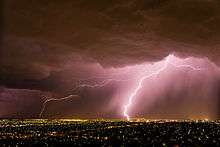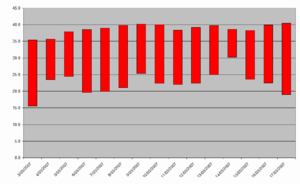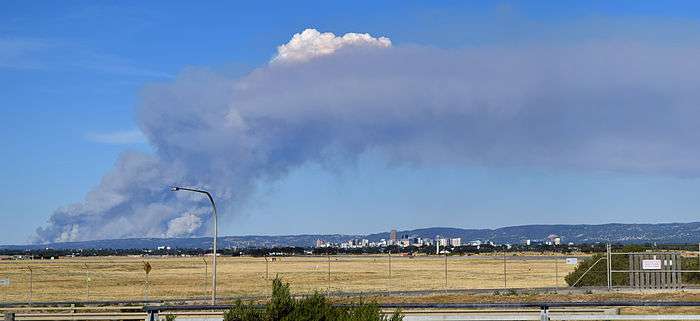Climate of Adelaide

Adelaide has a Mediterranean climate (Köppen climate classification Csa),[1] with cool to mild winters with moderate rainfall and warm to hot, generally dry summers.[2]
Adelaide is the driest of the Australian capital cities and the past two decades have been far warmer than usual, with the past 8 years seeing an excess of 40+ degrees every summer.
A spike in heat waves, droughts and record-breaking high temperatures over the past decade has led to some concerns over the effects of global warming and Man-made climate change (AGW) on the city.[3][4][5] Nine of the ten warmest years recorded in Adelaide have occurred since 2002, with 2013 being the hottest year and summer 2015–2016 being the fourth-hottest summer recorded.[6][7]
Seasonal variation
In summer (December to February) the average maximum is around 29 °C (84 °F), but there is considerable variation and Adelaide can usually expect several days a year when the daytime temperature is 39 °C (102 °F) and there are generally two or more days in which the maximum is 40 °C (104 °F) or slightly above. In winter (June to August) the average maximum is around 15–16 °C (59–61 °F) and the average minimum around 7–8 °C (45–46 °F). Frosts are common in the valleys of the Adelaide Hills, but rare elsewhere, with the most notable occurrences having occurred in July 1908 and July 1982. In winter, Adelaide experiences quite a significant wind chill, which makes the apparent temperature seem cooler than it actually is.
Rainfall is unreliable, light and infrequent throughout summer. The average in January and February is around (0.8 inches), but completely rainless months are by no means uncommon, and in 1893 sixty-nine days passed without measurable rainfall. In contrast, the winter has fairly reliable rainfall with June being the wettest month of the year, averaging around 80 mm.
Climate data and extremes
| Climate data for Adelaide (Kent Town, 1977–2013) | |||||||||||||
|---|---|---|---|---|---|---|---|---|---|---|---|---|---|
| Month | Jan | Feb | Mar | Apr | May | Jun | Jul | Aug | Sep | Oct | Nov | Dec | Year |
| Record high °C (°F) | 45.7 (114.3) |
44.7 (112.5) |
41.9 (107.4) |
36.9 (98.4) |
31.1 (88) |
25.4 (77.7) |
23.1 (73.6) |
30.4 (86.7) |
34.3 (93.7) |
39.0 (102.2) |
43.0 (109.4) |
43.4 (110.1) |
45.7 (114.3) |
| Mean maximum °C (°F) | 41.2 (106.2) |
39.8 (103.6) |
36.8 (98.2) |
31.3 (88.3) |
25.7 (78.3) |
20.8 (69.4) |
20.0 (68) |
23.2 (73.8) |
28.3 (82.9) |
33.1 (91.6) |
36.9 (98.4) |
38.9 (102) |
42.2 (108) |
| Average high °C (°F) | 29.4 (84.9) |
29.5 (85.1) |
26.5 (79.7) |
22.7 (72.9) |
19.0 (66.2) |
16.1 (61) |
15.3 (59.5) |
16.7 (62.1) |
19.1 (66.4) |
22.1 (71.8) |
25.3 (77.5) |
27.2 (81) |
22.4 (72.3) |
| Average low °C (°F) | 17.2 (63) |
17.3 (63.1) |
15.4 (59.7) |
12.5 (54.5) |
10.3 (50.5) |
8.2 (46.8) |
7.5 (45.5) |
8.2 (46.8) |
9.8 (49.6) |
11.5 (52.7) |
14.0 (57.2) |
15.6 (60.1) |
12.3 (54.1) |
| Mean minimum °C (°F) | 11.9 (53.4) |
11.8 (53.2) |
9.7 (49.5) |
7.4 (45.3) |
5.0 (41) |
3.0 (37.4) |
2.5 (36.5) |
3.1 (37.6) |
4.7 (40.5) |
6.1 (43) |
8.0 (46.4) |
9.9 (49.8) |
2.0 (35.6) |
| Record low °C (°F) | 9.2 (48.6) |
9.5 (49.1) |
7.2 (45) |
4.3 (39.7) |
1.5 (34.7) |
−0.4 (31.3) |
0.4 (32.7) |
1.6 (34.9) |
2.6 (36.7) |
4.7 (40.5) |
5.3 (41.5) |
8.0 (46.4) |
−0.4 (31.3) |
| Average rainfall mm (inches) | 20.9 (0.823) |
15.9 (0.626) |
27.4 (1.079) |
39.4 (1.551) |
60.8 (2.394) |
78.8 (3.102) |
77.4 (3.047) |
67.3 (2.65) |
59.7 (2.35) |
42.0 (1.654) |
29.6 (1.165) |
29.1 (1.146) |
551.0 (21.693) |
| Average rainy days (≥ 0.2 mm) | 4.7 | 3.6 | 5.9 | 8.1 | 12.5 | 15.0 | 16.4 | 16.3 | 13.5 | 10.0 | 8.1 | 7.1 | 121.2 |
| Average afternoon relative humidity (%) | 36 | 36 | 41 | 47 | 55 | 61 | 60 | 55 | 51 | 45 | 40 | 39 | 47 |
| Mean monthly sunshine hours | 325.5 | 285.3 | 266.6 | 219.0 | 167.4 | 138.0 | 148.8 | 186.0 | 204.0 | 257.3 | 273.0 | 294.5 | 2,765.4 |
| Source: Bureau of Meteorology.[8][9][10] | |||||||||||||
| Climate data for Adelaide Airport (1981-2014) | |||||||||||||
|---|---|---|---|---|---|---|---|---|---|---|---|---|---|
| Month | Jan | Feb | Mar | Apr | May | Jun | Jul | Aug | Sep | Oct | Nov | Dec | Year |
| Record high °C (°F) | 44.1 (111.4) |
43.6 (110.5) |
40.8 (105.4) |
36.9 (98.4) |
30.4 (86.7) |
26.1 (79) |
25.9 (78.6) |
29.9 (85.8) |
33.9 (93) |
38.0 (100.4) |
43.1 (109.6) |
42.4 (108.3) |
44.1 (111.4) |
| Average high °C (°F) | 28.1 (82.6) |
28.1 (82.6) |
25.5 (77.9) |
22.2 (72) |
18.5 (65.3) |
15.9 (60.6) |
14.9 (58.8) |
15.9 (60.6) |
18.2 (64.8) |
21.0 (69.8) |
23.9 (75) |
25.7 (78.3) |
21.5 (70.7) |
| Average low °C (°F) | 15.9 (60.6) |
16.1 (61) |
14.4 (57.9) |
11.8 (53.2) |
9.6 (49.3) |
7.6 (45.7) |
7.0 (44.6) |
7.5 (45.5) |
8.9 (48) |
10.6 (51.1) |
12.8 (55) |
14.5 (58.1) |
11.4 (52.5) |
| Record low °C (°F) | 7.9 (46.2) |
8.1 (46.6) |
4.6 (40.3) |
3.1 (37.6) |
−0.3 (31.5) |
−2.6 (27.3) |
−1.1 (30) |
−0.2 (31.6) |
1.1 (34) |
3.1 (37.6) |
4.2 (39.6) |
5.9 (42.6) |
−2.6 (27.3) |
| Average rainfall mm (inches) | 17.3 (0.681) |
18.1 (0.713) |
22.1 (0.87) |
35.5 (1.398) |
54.0 (2.126) |
56.6 (2.228) |
59.5 (2.343) |
50.5 (1.988) |
45.5 (1.791) |
37.2 (1.465) |
24.8 (0.976) |
23.8 (0.937) |
444.8 (17.512) |
| Average rainy days | 4.6 | 3.8 | 5.5 | 8.5 | 12.8 | 13.5 | 15.8 | 15.8 | 13.0 | 10.4 | 7.7 | 6.8 | 118.2 |
| Mean monthly sunshine hours | 325.5 | 280 | 269.7 | 219 | 173.6 | 141 | 155 | 192.2 | 213 | 260.4 | 279 | 288.3 | 2,796.7 |
| Source: Bureau of Meteorology [11] | |||||||||||||
Recorded extremes (records from West Tce weather station 1839-1977 & Kent Town weather station 1977–present):
- Hottest temperature: 46.1 °C (115.0 °F), 12 January 1939
- Coldest temperature: −0.4 °C (31.3 °F), 8 June 1982
- Hottest Minimum: 33.9 °C (93.0 °F), 29 January 2009
- Coldest Maximum: 8.3 °C (46.9 °F), 29 June 1922
- Wettest month: 217.9 mm (8.58 in), June 1916
- Wettest 24 hours: 141.5 mm (5.57 in), 7 February 1925
Extreme summer weather events: heatwaves, bushfires, droughts (2008–2018)
March 2008 heatwave

Between 3 March and 17 March 2008 Adelaide recorded 15 consecutive days of 35 °C (95 °F) or above, and 13 consecutive days of 37.8 °C (100.0 °F) or above — both records for an Australian capital city. (The record number of consecutive days of 37.8 °C (100.0 °F) or above in any Australian city is held by Marble Bar in Western Australia, which experienced 160 consecutive days in 1923–24.)
January–February 2009 heatwave
During January and February 2009 Adelaide was affected by the early 2009 southeastern Australia heat wave. The heatwave broke numerous records and affected all of south-eastern Australia, including Melbourne, another southern Australian city, where some outdoor games were cancelled during the 2009 Australian Open.
The heatwave commenced in Adelaide on 26 January 2009 (Australia Day), with a temperature of 36.6 °C (98 °F). From 27 January the temperature soared above 40 °C (104 °F) degrees for 6 consecutive days, until 2 February where the temperature dropped to 38.8 °C (102 °F). This is the longest straight run of 40 °C (104 °F) temperatures in Adelaide. On 28 January, the third day into the heatwave, the temperature reached 45.7 °C (114 °F), making it the third-hottest day on record in Adelaide. On that same night, the temperature only dipped to 33.9 °C (93 °F), making it the highest minimum temperature on record in South Australia (since surpassed). The maximum temperatures stayed higher than 30 °C (86 °F) for another six days, including two more 40-degree-plus days (6 and 7 February) until dropping back to 24.8 °C (77 °F) on 8 February 2009.
November 2009 heatwave
In November 2009 Adelaide was affected by the late 2009 southeastern Australia heatwave which occurred in the states of South Australia, Victoria and New South Wales. Daily maximum temperatures during the heat wave were roughly 10 °C (18 °F) above average in many locations. Capital cities Adelaide and Melbourne recorded temperatures over 40 °C (104 °F) and 35 °C (95 °F), respectively, which are unusual for November. Above-average temperatures in the region began in late October and persisted until mid-November 2009.
Temperature records for November in Adelaide set during the heatwave:
- 10 consecutive days over 30 °C (86 °F).
- 8 consecutive days over 35 °C (95 °F) – new record set on 13 November, breaking the previous record of 4 consecutive days, which was set in 1894.[12]
- 6 consecutive days over 38 °C (100 °F) – breaking the previous record of 3 consecutive days, which was set in 1888, 1922 and 1984.[13]
- Hottest November day – 43.0 °C (109.4 °F) on 19 November 2009 at 4:32pm ACDT, breaking the previous record of 42.0 °C (107.6 °F) set on 13 November 1993.[14]
Summer 2013–2014 heatwave
The summer of 2013–2014 was the second-hottest on record.[15] Records for Adelaide set during the 2013–2014 summer heatwave (beginning in December) include:[6]
- Hottest February day – 44.7 °C (112.5 °F) on 2 February 2014.
- Record number of days exceeding 40 °C (104 °F) during the summer months (December, January and February) – 13 so far.
- Record number of days exceeding 42 °C (108 °F) during a calendar year - 9 so far.
- Record number of consecutive days exceeding 42 °C (108 °F) – 5.
Autumn 2014: Warmest Adelaide autumn on record
Autumn 2014 was the fourth-warmest on record in South Australia,[16] and included a record run of 16 consecutive days in May with maximum temperatures over 20 °C within the city and metro areas, making it Adelaide's hottest autumn ever.[17][18]
2015 Sampson Flat bushfires
On 2 January 2015, after a day of extreme heat (a maximum temperature of 44.1 °C (111.4 °F)), a bushfire began burning in Sampson Flat, South Australia which then spread towards the outer northern suburbs of Adelaide, toward Greenwith and Golden Grove.[19] As the fire continued to burn out of control on 3 January 2015, it had posed the risk of spreading further into Adelaide's metropolitan area, with 27 homes destroyed.[20] The temperature for 3 January offered no avail to the fires, as it continued to hover in the low 40s. Despite beginning the month with several hot days, in 2015 Adelaide recorded its lowest January average temperature in over 10 years.[21]

October 2015: hottest October on record
October 2015 in Adelaide was the warmest on record for the city, continuing the trend of record breaking heat in the 2010s.[22] The temperature was approximately 5 °C (9.0 °F) degrees above the long term average.[23] Rainfall was also scarce for the month.[22]
December 2015: 5 consecutive days over 35 degrees and second heatwave for the summer
In early December, Adelaide experienced its hottest December night since 1897 and another heatwave–the temperature did not drop below 33 °C (91 °F) until 4am on 7 December.[24]
Following one of Adelaide's hottest nights on record, in mid December 2015, temperatures were forecasted to be above 35 °C (95 °F) for five consecutive days starting on 14 December, the third-most days over 35 °C (95 °F) in Adelaide's recorded history. This continues the trend that Adelaide has experienced since the early 2000s of summer heat exceeding maximum temperatures and breaking records. The heatwave in December 2015 marked Adelaide's record of five heatwaves in six years.
March 2016 heatwave
In early March, Adelaide endured 6 consecutive days in which the temperature reached above 30 °C (86 °F). On the 5, 6 and 8 March, the temperature approached maximums of 37 °C (99 °F) and 38 °C (100 °F) degrees. Rain during this period increased the humidity level in the city, and flash flooding was recorded in the suburbs, as temperatures dropped back into the high 20s on 9 March.
Hottest Christmas Day in 75 years and February 2017 heatwave
On 25 December 2016, Adelaide experienced its hottest Christmas Day since 1941.[25] The mercury reached 41.3 °C (106.3 °F). That following February, a heatwave was recorded in Adelaide as the temperature climbed above 40 °C (104 °F) for 3 consecutive days, with the minimum overnight temperature not dropping below 30 °C (86 °F) on 9 February.[26] Blackouts across the city complicated the conditions further.[26]
Winter 2017: Second lowest June rainfall in Adelaide's recorded history
Adelaide recorded its second driest June in recorded history, and the driest in 59 years.[27] Less than fell in the entire month, recording only . Agricultural regions across South Australia were also effected, experiencing the third driest winter on record.
Summer 2017-2018: twelve consecutive days above 30 degrees and various heatwaves
Summer 2017-18 was another hot summer for Adelaide. Beginning on 17 January 2018, the daytime temperature in Adelaide did not drop below 30 °C (86 °F) with forecasts of temperatures above 37 °C (99 °F) up until 29 January. Two of these days, 19 January and 20 January, reached temperatures of above 40 °C (104 °F), while three days recorded temperatures at 37 °C (99 °F) or above resulting in a heatwave, and two more are predicted to reach temperatures of 40 °C (104 °F).
- Total number of days with temperatures of 37 °C (99 °F) or above in Adelaide for summer 2017-18: 12.
- Total number of days with temperatures of 40 °C (104 °F) or above: 5.
See also
References
- ↑ Tapper, Andrew; Tapper, Nigel (1996). Gray, Kathleen, ed. The weather and climate of Australia and New Zealand (First ed.). Melbourne, Australia: Oxford University Press. p. 300. ISBN 0-19-553393-3.
- ↑ Griffin, T. & McCaskill, M. (Editors, 1986): Atlas of South Australia. South Australian Government Printing Division in association with Wakefield Press on behalf of the South Australia Jubilee 150 Board, Adelaide. ISBN 0 7243 4688 0
- ↑ Cook, Craig (11 February 2014). "Today's top of breaks new record in South Australia of number of summer days with maximum over 40 degrees". The Australian. Retrieved 11 February 2014.
- ↑ "Climate change in South Australia". Retrieved 11 February 2014.
- ↑ "Heatwaves increasing in Australia". Retrieved 11 February 2014.
- 1 2 Bureau of Metereology says heavy rains on way across South Australia on Friday, after scorching heat, The Australian, 12 February 2014
- ↑ "Adelaide in Summer 2016". Bureau of Meteorology. Retrieved 16 March 2016.
- ↑ "Climate statistics for ADELAIDE (KENT TOWN)". Climate statistics for Australian locations. Bureau of Meteorology. Retrieved June 18, 2017.
- ↑ "Lowest Temperature - 023090". Bureau of Meteorology. Retrieved June 18, 2017.
- ↑ "Highest Temperature - 023090". Bureau of Meteorology. Retrieved June 18, 2017.
- ↑ "Climate Statistics for Adelaide Airport (1955-2012)". Retrieved February 24, 2014.
- ↑ "Adelaide sweats in landmark heatwave". ABC News Online. 12 November 2009. Retrieved 12 November 2009.
- ↑ Dutschke, Brett (12 November 2009). "Little relief from record heat in SA". Weatherzone. Retrieved 12 November 2009.
- ↑ "Adelaide, South Australia November 2009 Daily Weather Observations". Bureau of Meteorology.
- ↑ "Adelaide's hottest summer on record". ABC Online. 11 February 2014. Retrieved 4 June 2014.
- ↑ "South Australia in Autumn 2014". Retrieved 11 June 2014.
- ↑ BoM: Adelaide Metro & Hills in May 2014: A warm end to autumn Accessed 5 June 2014.
- ↑ BoM: Special Climate Statement 49 – an exceptionally prolonged autumn warm spell over much of Australia 4 June 2014. Accessed 5 June 2014.
- ↑ "Bushfires: five SA homes destroyed, Victoria braces for more blazes". The Australian. 3 January 2015.
- ↑ "At least four houses destroyed by bushfire near Kersbrook in Adelaide Hills, CFS confirms". ABC Australia. 3 January 2015.
- ↑ Adelaide has mildest January in more than 10 years: weather bureau ABC News, 1 Feb 2015. Accessed 6 March 2015.
- 1 2 "Adelaide's hottest October on record: Temperature 5 degrees hotter than the average, rainfall scarce". ABC News. 2 November 2015.
- ↑ "Hot and dry October conditions expected to continue into November". 1 November 2015. Retrieved 2 November 2015.
- ↑ "Adelaide swelters through hottest December night since 1897, as fourth day of heatwave expected". ABC Online. 7 December 2015. Retrieved 15 December 2015.
- ↑ "SA News: It was Adelaide's hottest Christmas Day in 75 years but storms are developing on the west coast". Adelaide Now. 25 December 2016. Retrieved 7 February 2017.
- 1 2 "Rolling blackouts ordered as Adelaide swelters during heatwave". Adelaide Now. 9 February 2017. Retrieved 11 February 2017.
- ↑ "Adelaide records lowest June rainfall in 59 years as winter dry spell frustrates farmers". Australian Broadcasting Corporation. 30 June 2017. Retrieved 17 January 2018.